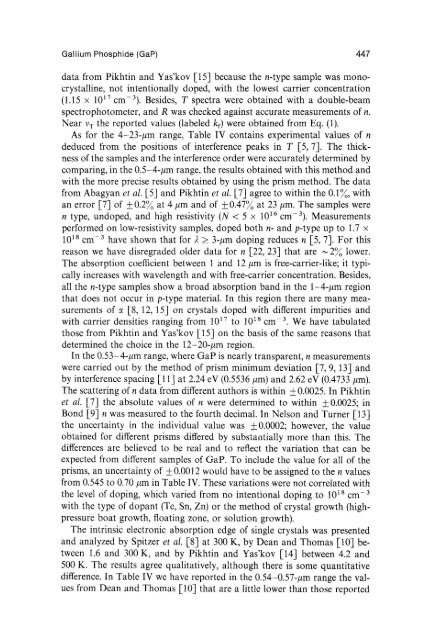Gallium Arsenide (GaAs) - Courses
Gallium Arsenide (GaAs) - Courses
Gallium Arsenide (GaAs) - Courses
You also want an ePaper? Increase the reach of your titles
YUMPU automatically turns print PDFs into web optimized ePapers that Google loves.
<strong>Gallium</strong> Phosphide (GaP) 447<br />
data from Pikhtin and Yas'kov [15] because the n-type sample was monocrystalline,<br />
not intentionally doped, with the lowest carrier concentration<br />
(1.15 x 10 17 cm- 3 ). Besides, T spectra were obtained with a double-beam<br />
spectrophotometer, and R was checked against accurate measurements of n.<br />
Near V T the reported values (labeled kr) were obtained from Eq. (1).<br />
As for the 4-23-pm range, Table IV contains experimental values of n<br />
deduced from the positions of interference peaks in T [5,7J. The thickness<br />
of the samples and the interference order were accurately determined by<br />
comparing, in the 0.5-4-pm range, the results obtained with this method and<br />
with the more precise results obtained by using the prism method. The data<br />
from Abagyan et at. [5] and Pikhtin et at. [7] agree to within the 0.1 %, with<br />
an error [7] of ±0.2% at 4 pm and of ±0.47% at 23 pm. The samples were<br />
n type, undoped, and high resistivity (N < 5 x 10 16 cm - 3). Measurements<br />
performed on low-resistivity samples, doped both n- and p-type up to 1.7 X<br />
10 18 cm - 3 have shown that for )" :;::: 3-pm doping reduces n [5, 7]. For this<br />
reason we have disregraded older data for n [22, 23] that are '" 2% lower.<br />
The absorption coefficient between 1 and 12 pm is free-carrier-like; it typically<br />
increases with wavelength and with free-carrier concentration. Besides,<br />
all the n-type samples show a broad absorption band in the 1-4-pm region<br />
that does not occur in p-type material. In this region there are many measurements<br />
of a [8, 12, 15] on crystals doped with different impurities and<br />
with carrier densities ranging from 10 17 to 10 18 cm - 3. We have tabulated<br />
those from Pikhtin and Yas'kov [15] on the basis of the same reasons that<br />
determined the choice in the 12-20-pffi region.<br />
In the 0.53-4-pm range, where GaP is nearly transparent, n measurements<br />
were carried out by the method of prism minimum deviation [7, 9, 13] and<br />
by interference spacing [11] at 2.24 eV (0.5536 pm) and 2.62 eV (0.4733 pm).<br />
The scattering of n data from different authors is within ± 0.0025. In Pikhtin<br />
et at. [7] the absolute values of n were determined to within ±0.0025; in<br />
Bond [9J n was measured to the fourth decimal. In Nelson and Turner [13J<br />
the uncertainty in the individual value was ±0.0002; however, the value<br />
obtained for different prisms differed by substantially more than this. The<br />
differences are believed to be real and to reflect the variation that can be<br />
expected from different samples of GaP. To include the value for all of the<br />
prisms, an uncertainty of ±0.0012 would have to be assigned to the n values<br />
from 0.545 to 0.70 pm in Table IV. These variations were not correlated with<br />
the level of doping, which varied from no intentional doping to 10 18 cm - 3<br />
with the type of dopant (Te, Sn, Zn) or the method of crystal growth (highpressure<br />
boat growth, floating zone, or solution growth).<br />
The intrinsic electronic absorption edge of single crystals was presented<br />
and analyzed by Spitzer et al. [8] at 300 K, by Dean and Thomas [10J between<br />
1.6 and 300 K, and by Pikhtin and Yas'kov [14J between 4.2 and<br />
500 K. The results agree qualitatively, although there is some quantitative<br />
difference. In Table IV we have reported in the 0.54-0.57-pm range the values<br />
from Dean and Thomas [lOJ that are a little lower than those reported
















